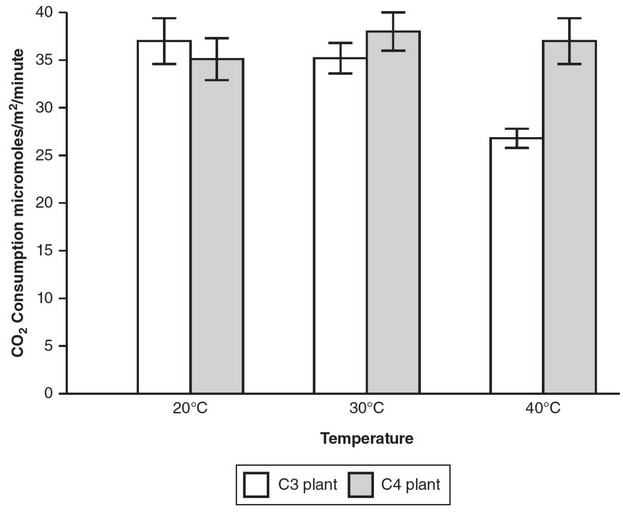Question
In order to investigate the possible effects that chemicals in a certain insecticide have on plant growth, a researcher grew 100 plants from each of three different crop species. Fifty plants of each type were grown in a lab in the presence of the insecticide, and the other 50 plants of each type were grown in a lab without insecticide. All plants were grown to maturity and then dried, and the mean dry weight per plant and the standard error of the mean were calculated for each group. Data are shown in the table.
*Standard Error of the Mean
(a) Describe the effect of the use of the insecticide on the mean dry weight of crop B.
(b) Calculate which crop (A, B, or C) had the greatest percent increase in mean dry weight in the presence of the insecticide.
Show your work.
(c) The researcher makes the claim that use of this insecticide increases the mean dry weight of all three crops. Using the data from the table, evaluate the researcher’s claim.
(d) Explain why the use of an insecticide could increase the yield of some agricultural crops.
▶️Answer/Explanation
Ans:
(a) The use of the insecticide significantly increased the mean dry
weight of crop B. The upper limit of the 95% confidence interval
for crop B without the insecticide is 9.13, and the lower limit of the
95% confidence interval for crop B in the presence of the insecticide is 9.44. So there is likely a significant difference
between the two groups.
(b) Percent increase in mean dry weight = \(\frac{mean dry weight in the presence of insecticide – mean dry weight without insecticide }{ mean dry weight without insecticide}.\) \times 100\)
Crop A = \(\frac{14.02 – 12.10}{12.40} \times 100 = 13 %\)
Crop B = \(\frac{10.02 – 8.63}{8.63} \times 100 = 16%\)
Crop C = \(\frac{19.54 – 15.64}{15.64} \times 100 = 25 %\)
Crop C has the greatest percent increase in mean dry weight.
(c) The researcher’s claim is not supported by the data. This is because
the 95% confidence intervals for plants from crop A grown with
and without insecticide overlap: the upper limit of the 95%
confidence interval for crop A without insecticide is 13.40 and the
lower limit of the 95% confidence interval for crop A in the
presence of insecticide is 12.90. Therefore, it cannot be concluded
that there is a significant difference between those two groups for
crop A.
(d) Many insects consume plant material and are therefore primary
consumers. The use of insecticides would decrease the number of
primary consumers and could thereby increase the crop yield.
Question
Plants thought to have evolved in temperate climates use C3 photosynthesis (also known as the light-independent cycle). Plants
thought to have evolved in tropical climates use an additional step referred to as C4 photosynthesis. Scientists measured the
photosynthetic rate of C3 plants (sugar beets) and C4 plants (sugarcane) in a sealed container under three different temperature
conditions. Data are shown in the table.
*Standard Error of the Mean
(a) Explain why the rate of carbon dioxide consumption was used in this experiment.
(b) Construct a graph of the data, showing 95% confidence intervals.
(c) Analyze the data, and determine at which temperature(s) there was a statistically significant difference in carbon dioxide consumption in C3 and C4 plants.
(d) Coleus is a popular C3 houseplant. A person has a Coleus plant inside her climate-controlled home, in which the temperature never exceeds 30° Celsius. If this plant was placed outside for seven days during a heat wave (in which the high temperature each day reached 39°C), predict the effect this would have on the plant. Justify your prediction.
▶️Answer/Explanation
Ans:
(a) Carbon dioxide is a reactant that is consumed during
photosynthesis, so measuring the rate of carbon dioxide consumption could be a good way to compare the rate of
photosynthesis between these two organisms.
(b) 
(c) There is likely a statistically significant difference at a temperature
of 40°C because the 95% confidence intervals for the C3 and C4
plants do not overlap at that temperature, but they do overlap at
20°C and 30°C.
(d) The plant would likely consume less carbon dioxide and would
perform less photosynthesis in a 39°C environment than in a 30°C
environment. It would have fewer organic compounds with which
to supply itself with energy. This is because the data show that a C3
plant will consume less carbon dioxide at 40°C (compared to at
30°C), so it will probably perform less photosynthesis when
exposed to heat wave temperatures.
Question
Biological oxygen demand (BOD) is the amount of dissolved oxygen needed by the organisms in a particular body of water to decompose the organic material present in a specified amount of time.
Explain how increasing the concentration of phosphorus in a lake creates a biological oxygen demand (BOD).
State one human activity that is likely to result in increased organic material in a body of water.
▶️Answer/Explanation
Ans:
Biological oxygen demand (BOD) is the amount of dissolved oxygen
needed by the organisms in a particular body of water to decompose the
organic material present in a specified amount of time. Eutrophication (or
hypertrophication) is the enrichment (or over-enrichment) of water by
nutrients. It results in excessive bacterial and/or algae growth, often called
blooms. When these organisms die, the oxidative breakdown of the detritus
leads to an oxygen shortage. Depletion of surface oxygen can suffocate fish
and other obligate aerobes.
Human activities that enrich bodies of water are dumping raw sewage
and farming in places where the runoff enters the drainage basin.
